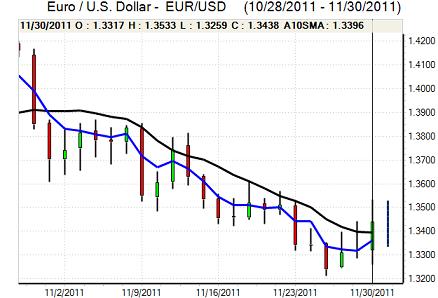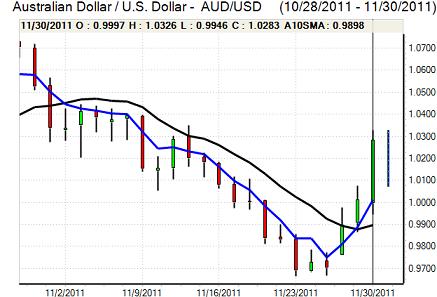EUR/USD
The Euro initially consolidated in the 1.33 area against the dollar on Wednesday before moving sharply higher early in New York.
Risk appetite was boosted initially by the Chinese central bank decision to cut reserve ratio requirements with the move intensifying sharply following co-ordinated action by the global central banks. The Federal Reserve and other central banks announced that they would cut the cost of dollar swap rates and increase liquidity in the market. The net impact of this will be to make dollar borrowing less costly and make it easier for banks to access funding which was disappearing rapidly. The immediate impact will be to lessen the threat of a major banking-sector collapse triggered by liquidity difficulties.
EU governments also confirmed the scheme to provide guarantees for long-term debt issuance and there was optimism that this would help to improve access to wholesale funding markets. There was a surge in risk appetite which cut defensive dollar demand and also boosted the Euro.
The US economic data was again better than expected with an ADP private-sector employment increase of 206,000 for November from a revised 130,000 previously while the Chicago PMI index rose to 62.6 from 58.4 and pending home sales rose strongly. The data increased optimism that there would be a solid employment report on Friday which also improved risk conditions.
The central bank actions may have bought some time, but there were still major concerns surrounding the underlying Euro-zone outlook as underlying sovereign-debt pressures continued to increase. There was increased speculation that the ECB would cut interest rates at next week’s meeting and further pressure for the central bank to take a more aggressive stance on peripheral bond intervention.
The Euro pushed to highs just above 1.35 against the dollar before retreating back to the 1.3450 area in Asian trading on Thursday.

Source: VantagePoint Intermarket Analysis Software
Call now and you will be provided with FREE recent forecasts
that are up to 86% accurate* 800-732-5407
If you would rather have the recent forecasts sent to you, please go here
Yen
The dollar was unable to hold a position above 78 against the yen on Wednesday and dipped to lows near 77.35 following the Federal Reserve swap announcement before edging back to the 77.65 area.
Although it did weaken, the yen was still broadly resilient on the crosses despite a sharp rally in global equity prices.
The yen will tend to lose defensive support if risk aversion eases, but there will still be the threat of longer-term capital repatriation back to Japan which will provide important underlying support.
China’s official PMI reading for November was also below the 50 level at 49.0 which maintained concerns surrounding the outlook, although a weak figure had been expected which limited the impact.
Sterling
Sterling moves were dominated by international developments on Wednesday and it pushed sharply higher to a peak near 1.5750 due to wider US currency losses. Sterling also gained support from a wider improvement in risk appetite as global equity markets rallied sharply. The UK currency will remain very sensitive to developments within the banking sector and any improvement in financing conditions should provide net support.
There will still be a high degree of unease over the economic outlook, especially with the government warning over the risk of a fresh credit crunch. Any sustained improvement in Euro-zone risk conditions could also tend to dampen defensive demand for the UK currency.
The budget and growth outlook will also be watched very closely as there will be a high risk of the UK moving to an unsustainable medium-term position in the event of another recession which would result in multiple credit-rating downgrades. Sterling consolidated in the 1.57 area in Asia on Thursday with underlying risk conditions still favourable.
Swiss franc
The dollar hit tough resistance in the 0.9250 area against the franc on Wednesday and then retreated very sharply to lows below 0.91 following the central bank agreement to lower swap rates. The Euro was able to make some headway, but there was resistance close to 1.23. A sustained improvement in risk appetite would tend to curb defensive demand for the franc.
The KOF business confidence index weakened to 0.35 for November from a revised 0.75 previously which will maintain fears over a further deterioration in the economy and will also maintain pressure for National Bank action to weaken the franc further.

Source: VantagePoint Intermarket Analysis Software
Call now and you will be provided with FREE recent forecasts
that are up to 86% accurate* 800-732-5407
If you would rather have the recent forecasts sent to you, please go here
Australian dollar
The Australian dollar regained party against the US currency following the Chinese move to lower reserve requirements and then moved very sharply higher following the central bank move to cut swap rates. As risk appetite and equity markets surged higher, the Australian currency moved sharply higher to a peak near 1.03.
The domestic economic data was weaker than expected with a subdued 0.2% increase in retail sales for October while there was a sharp 10.7% decline in building approvals which revised doubts surrounding the housing sector while the manufacturing PMI index remained below the 50 level. There were also still underlying fears surrounding the international outlook which kept sentiment in check.



